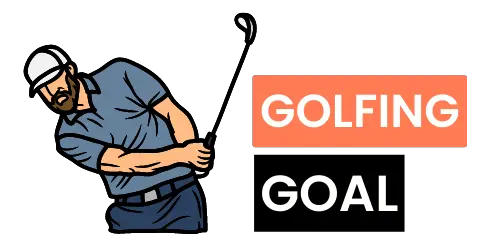
Is your 48 Volt EZ GO Golf Cart refusing to charge properly? It’s a common issue that can throw a wrench in your plans for a leisurely day on the green.
This article shines a light on the charging challenges faced by many golf cart owners.
We delve into the problem, exploring potential causes like faulty chargers, worn-out batteries, and elusive wiring issues.
By breaking down these complex issues into understandable solutions, we aim to guide you through a straightforward path to getting your cart charged and ready for action. 🛠️🔌🏌️♂️
Common 48 Volt EZ GO Golf Cart Charging Problems
1. Faulty Batteries
The core issue with faulty batteries lies in their inability to hold a charge due to degradation over time or from being over-discharged.
This degradation results from the breakdown of the battery’s internal components, leading to a significant decrease in performance.
Symptoms include a noticeable drop in the cart’s range and power.
2. Malfunctioning Charger
When facing a scenario where your 48-volt golf cart charger is not working, the fault could be due to internal failures such as damaged circuits or outdated firmware that fails to communicate effectively with the cart’s battery management system.
This miscommunication can prevent the charger from initiating or completing the charging cycle.
Are the Cazador Golf Cart Problems Similar to the EZ GO Golf Cart Charging Problems?
Yes, the common problems with golf carts can be similar between Cazador and EZ GO models. Both can experience charging issues, such as battery degradation, faulty chargers, or electrical system malfunctions. It’s important to troubleshoot and address these issues promptly to ensure proper functioning of the golf cart.
3. Charging Port Issues
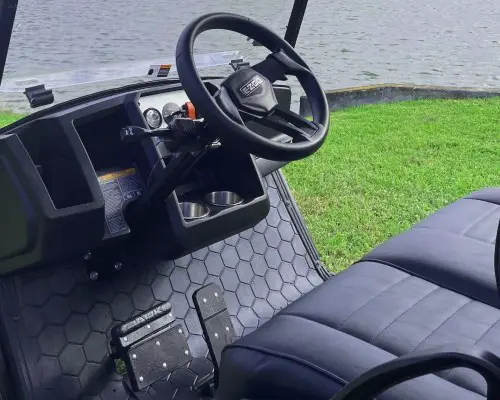
Damage or corrosion within the charging port can interrupt the connection between the charger and the cart.
In some cases, this physical barrier manifests as resistance when plugging in the charger or fluctuating charge status, indicating an inconsistent connection that prevents proper charging.
4. Damaged Cables or Connectors
Wear and tear on cables or connectors can lead to exposed wires or broken connections, hindering the flow of electricity.
This damage often results from environmental exposure or physical stress, leading to intermittent charging or complete failure to charge.
5. Electrical System Issues
These encompass a range of problems, from short circuits to blown fuses within the cart’s electrical system.
Such issues disrupt the flow of electricity to the battery, often indicated by a total lack of power or unpredictable cart behavior during operation.
6. Voltage Regulator Failures
The voltage regulator maintains the battery charging voltage within safe limits.
Failure in this component can lead to overcharging or undercharging, both of which are harmful to the battery’s longevity.
Symptoms include batteries that remain undercharged or exhibit signs of bulging from overcharging.
7. Temperature Sensor Issues
Incorrect temperature readings can cause the charging system to prematurely halt the charge, mistaking the normal temperature for an overheating condition.
Conversely, it might not charge if the sensor falsely indicates a too-low temperature, impacting the cart’s usability in different climates.
8. Solenoid Problems
The solenoid acts as a switch, controlling power flow from the battery to the cart’s drive system.
A malfunctioning solenoid may fail to engage, leading to a situation where the cart does not start or move, despite the battery being adequately charged.
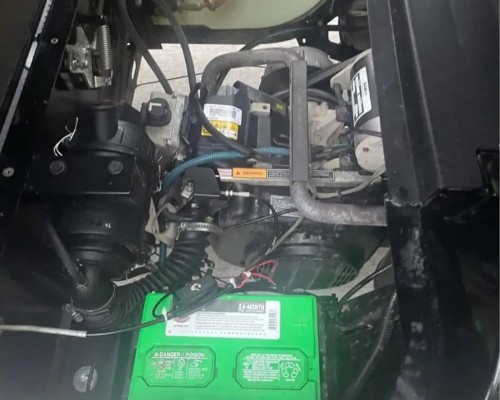
Diagnosing 48 Volt EZ GO Golf Cart Charging Problems
Tools and Equipment Needed
For effective diagnosis, acquire a multimeter, a hydrometer, and protective gear.
These tools help assess battery health, charger output, and circuit continuity. Ensure safety first.
Step-by-step Diagnostic Process
1. Battery Inspection and Testing
First, visually inspect the battery for damage or corrosion. Use a hydrometer to check each cell’s specific gravity, indicating battery health.
A multimeter measures voltage, ensuring it matches the expected 48 volts. These steps identify if the battery is the fault source.
2. Charger Functionality Test
When your 48-volt golf cart charger is not working, start by verifying the charger’s power supply. Ensure it’s plugged into a functioning outlet.
Use a multimeter to check the charger’s output. If it shows no output, the charger might need repair or replacement.
3. Cable and Connector Inspection
Examine cables and connectors for wear, corrosion, or damage. Faulty connections can disrupt charging. Ensure all connections are tight and clean.
Replace any compromised parts to ensure efficient charge flow.
4. Electrical System Check
Lastly, inspect the golf cart’s electrical system. Check the continuity of wiring with a multimeter. Inspect the fuse and breaker for signs of tripping or damage.
This step ensures the entire electrical pathway supports proper charging.
Solutions 48 Volt EZ GO Golf Cart Charging Problems
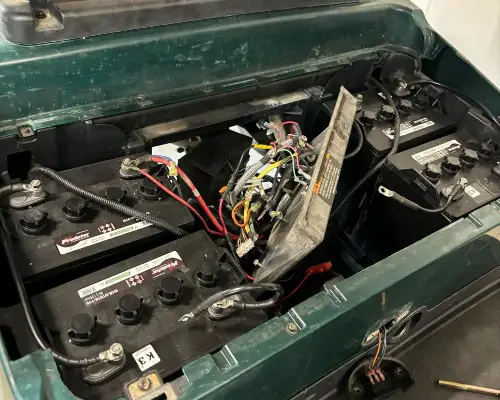
1. Fixing Battery-Related Issues
- Replacing Batteries
Over time, golf cart batteries lose their ability to hold a charge. If your cart’s performance drops, measure each battery’s voltage and specific gravity.
Replace batteries that fail to meet the 48-volt system’s requirements. This ensures consistent power delivery.
- Equalizing Charge for Batteries
Batteries can develop unequal charge levels, affecting performance.
An equalizing charge applied regularly, balances the battery cells. It’s crucial when your 48-volt golf cart charger isn’t working correctly.
This process reverses acid stratification and sulfation, extending battery life.
2. Repairing or Replacing the Charger
A malfunctioning charger can’t properly replenish your golf cart’s batteries. Inspect the charger for physical damage and test its output voltage. A charger failing to produce the required voltage needs repair or replacement. Ensure compatibility with your golf cart’s 48-volt system for efficient charging.
3. Addressing Cable and Connector Issues
Faulty cables and connectors hinder electricity flow, causing charging problems. Inspect all cables for signs of wear, corrosion, or damage. Replace any defective parts. Secure and clean connections improve charge efficiency and prevent voltage drops.
4. Resolving Electrical System Malfunctions
Electrical system faults in golf carts are complex. Issues like a malfunctioning solenoid, faulty ignition switch, or compromised wiring can prevent proper charging. Diagnose the system with a multimeter. Repair or replace defective components to restore charging functionality.
Preventive Measures & Maintenance Tips For EZ GO Golf Cart Charging Problems
1. Regular maintenance schedule for the charging system
Set a routine to inspect and maintain your cart’s charger and connections. Check for loose, corroded, or damaged wires monthly.
Ensure the charging port and charger plug are clean. This prevents power issues and maintains charging efficiency.
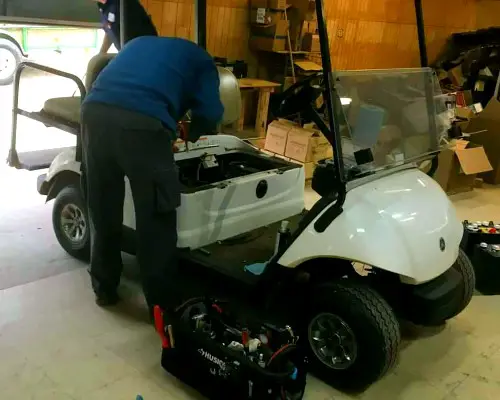
2. Tips for extending battery life
To address a 48-volt golf cart charger not working, verify the battery water level every month. Use distilled water for refills, never overfilling.
Keep the battery terminals clean and tight. This care prolongs battery life, ensuring reliable performance.
3. How to properly charge your golf cart?
Always charge your golf cart after use, regardless of the duration. Use the manufacturer-recommended charger for your model.
Avoid interrupting the charging cycle until complete. This habit maximizes battery capacity and lifespan.
4. When to seek professional help
If your golf cart fails to charge after troubleshooting, consult a professional. Warning signs include unusual noises during charging, reduced speed, or rapid battery drain.
A technician can diagnose issues beyond basic maintenance, like deep-seated electrical problems.
Final Thoughts!
Understanding your 48 Volt EZGO Golf Cart’s charging problems requires a comprehensive approach.
This guide has explored common issues from faulty batteries to complex electrical system malfunctions.
Proper diagnosis involves using specific tools and knowledge of the cart’s system. You may need to seek professional assistance if you haven’t succeeded in following these steps.
FAQs
Does the EZ GO charger have a fuse?
Yes, EZ GO chargers typically have a fuse. It’s part of the internal circuitry. This fuse protects against electrical surges.
If your charger stops working, check this fuse first. A blown fuse indicates it protected your charger from damage.
Replacement is straightforward but must match the original specifications.

Bob is a golf equipment expert with a wealth of knowledge about the latest and greatest golfing gear. Bob is our Lead Product Reviewer and provides in-depth reviews and recommendations on the best equipment for golfers of all levels. He takes a hands-on approach to testing, using his extensive experience on the course to provide the most accurate and reliable product recommendations. Join Our Team!
